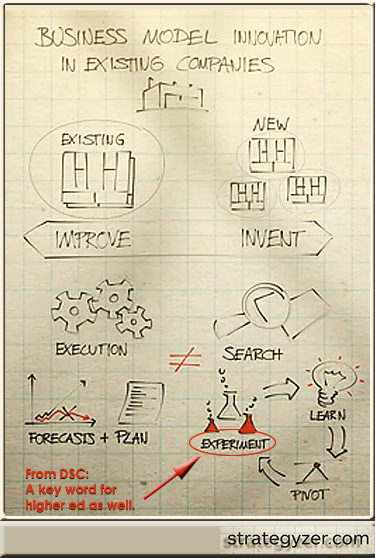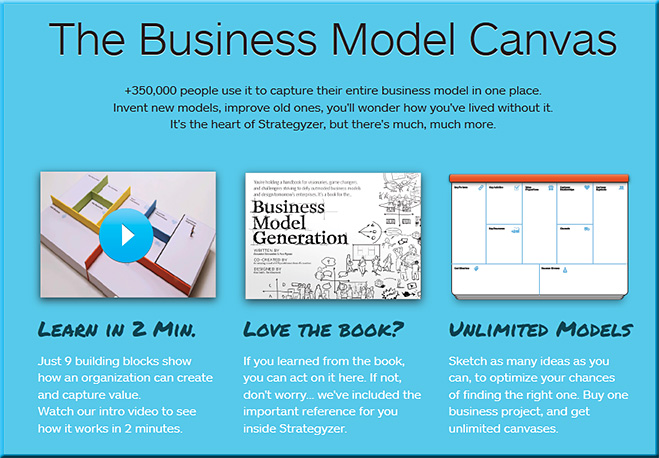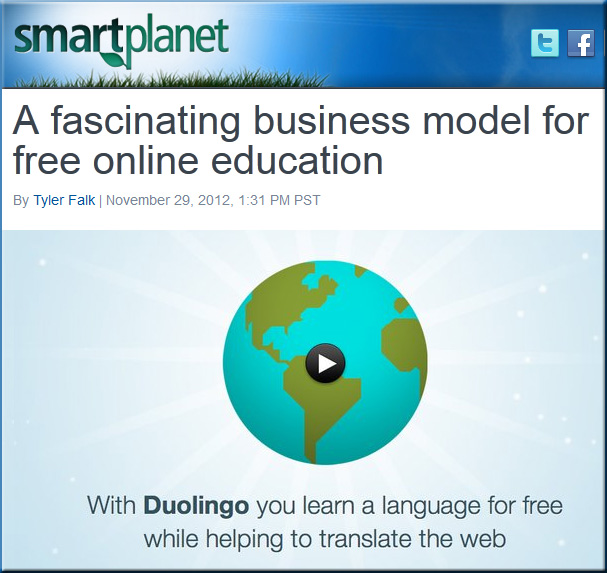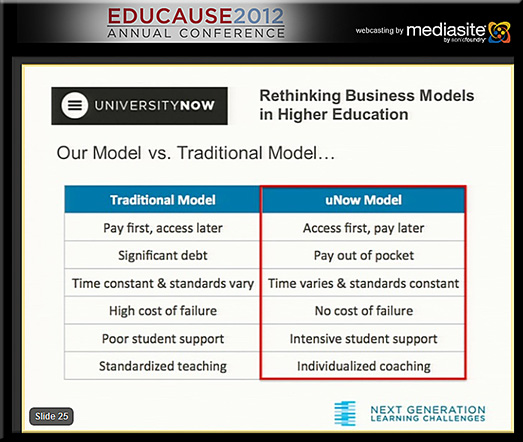UK university joins US online partnership — from bbc.co.uk by Sean Coughlan BBC News education correspondent

Daphne Koller, co-founder of Coursera, and Edinburgh University’s principal,
Sir Timothy O’Shea, sign up to the online partnership




UK university joins US online partnership — from bbc.co.uk by Sean Coughlan BBC News education correspondent

Also see:
Excerpt:
Today Udacity is thrilled to announce a partnership with San Jose State University to pilot three courses — Entry-Level Mathematics, College Algebra, and Elementary Statistics — available online at an affordable tuition rate and for college credit. To my knowledge, this is the first time a MOOC has been offered for credit and purely online. Much credit for this partnership goes to Mo Qayoumi and Ellen Junn, president and provost of SJSU, and to the five fearless SJSU professors who have chosen to work with us at Udacity to explore this new medium. The offices of Governor Brown and CSU Chancellor White have also been critically important to this partnership for their leadership and expediency. Last but not least, I want to personally thank our great Udacians who, like everyone on this list, have worked endless hours to drive innovation.
Over the past year, MOOCs have received a lot of attention in the media and education circles mostly because so many students are taking advantage of the course for free. Predictions that MOOCs would fundamentally change higher education often revolved around the fact that the courses have unprecedented reach and affordability.
From DSC:
Given that such “Walmarts of Education” (i.e. solid learning at a greatly reduced prices) continue to develop, what’s our/your plans for responding to this trend? How are we/you going to compete? What’s our/your vision and strategy? By the way, you can look all you want to for data — but at the end of the day, it’s likely with this sort of thing that you won’t find all of the data that you require to make a decision. Examples:
Colleges lose pricing power — from the WSJ by Michael Corkery
Excerpt (emphasis DSC):
The demand for four-year college degrees is softening, the result of a perfect storm of economic and demographic forces that is sapping pricing power at a growing number of U.S. colleges and universities, according to a new survey by Moody’s Investors Service.
Facing stagnant family income, shaky job prospects for graduates and a smaller pool of high-school graduates, more schools are reining in tuition increases and giving out larger scholarships to attract students, Moody’s concluded in a report set to be released Thursday.
.
From DSC:
To me, this is just another way of saying the higher education bubble is popping. I think the bubble may pop at different times for different institutions, but the overall picture is clear: Higher ed will either reinvent itself — and hopefully quickly — or it will lose a portion of its relevance and place in society (how much is ultimately lost depends upon how much higher ed can experiment, innovate, and reinvent itself).
Also relevant here:
From DSC:
Whereas:
…institutions of higher education would be wise to significantly increase the priority of experimentation on their campuses during 2013. This might take the form of creating smaller, more nimble organizations within their overall universities or colleges, or it might be experimenting with new business models, or it might be identifying/experimenting with promising educational technologies or new pedagogies, etc. I will have several blog postings re: experimentation — and potential things to try out — during 2013; so stay tuned.
Whether we are staff, faculty, or administration, change is coming our way in 2013. So starting today, get involved with further innovations and experiments on your campus — don’t be a roadblock or you will likely find your institution eventually becoming irrelevant. As Steve Jobs did/believed, cannibalize your own organization before someone else does.

Combine the trends listed in this graphic:
.
— from The Economics of Higher Education, Dec 2012 (pg 2)
…with the next several graphics…
.
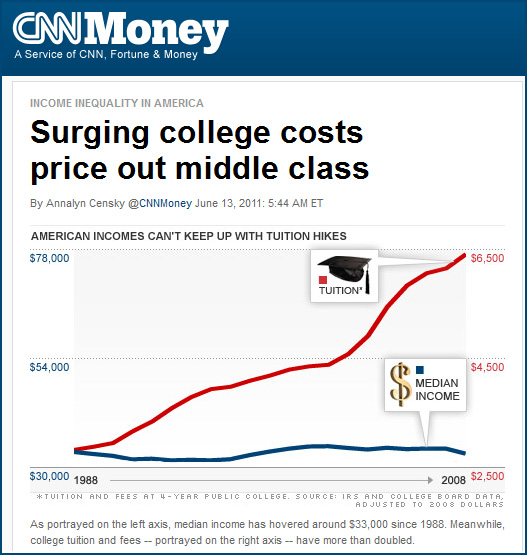
.
.
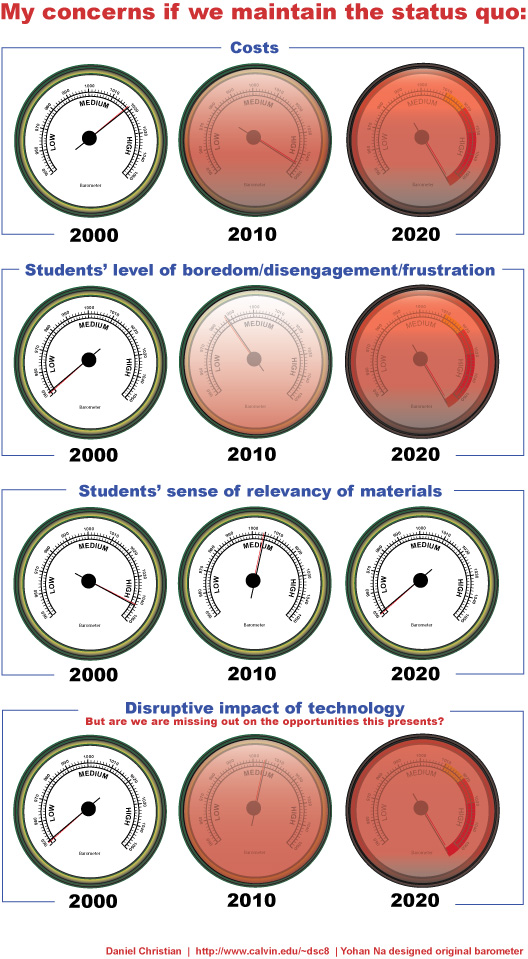
From 5/21/09
…and you can see that the Perfect Storm in Higher Ed has been amassed. Massive change is in the air. People will find a way to achieve their goals/objectives — one way or another. College is still a good call — but what “college” and “university life” will look like in 5 years will likely be very different from what they look like today.
There is no returning to the “good ol’ days” — things are not going back to the way they were 5-10 years ago. It’s time for massive — but controlled/intentional — experimentation within higher ed, to find out how best to use the Internet in order to promote learning (and, hopefully, to still make a living!).
.

Some examples that illustrate that change is in the air…and that the conversation continues to move outside traditional institutions of higher education (I mention these not to dog higher ed, but to get us to innovate, to reinvent ourselves, and to stay relevant!)
Big idea 2013: College becomes optional — from LinkedIn.com by Ben Smith
Jailbreaking the degree: The end of the 4 year diploma — from onlineuniversities.com by Justin Marquis
Excerpt:
What’s wrong with getting a college degree? According to the grassroots movement, “Jailbreaking the Degree,” being pushed by radical education startup Degreed.com, quite a bit. The organization has identified several fundamental flaws with the long standing college degree process. It aims to overcome them and dramatically change the nature of learning and credentialing in the process. In order to justify their initiative they present some dramatic numbers on their website…
Degreed wants to jailbreak the college degree — from techcrunch.com by Rip Empson
Saying no to college — NYT.com by Alex Williams
Do a Google search on uncollege.org and see what you get
The rise of college alternatives— from huffingtonpost.com by Dan Schawbel
educreations.com: Teach what you know. Learn what you don’t.
The future of corporate innovation and entrepreneurship — from SteveBlank.com
Excerpt:
A New Strategy for Entrepreneurship in the 21st Corporation
Yet, simply focusing on improving existing business models is not enough anymore. To assure their survival and produce satisfying growth, corporations need to invent new business models. This challenge requires entirely new organizational structures and skills.
Also see:
strategyzer.com
Addendum on 12/14/12:
From DSC:
We had better step up the pace of innovating/experimenting – and move to do so quickly. But the problem is, moving quickly is not in the cultures of most of the more traditional institutions of higher education.
Also relevant:
From DSC:
Some reflections on New platform lets professors set prices for their online courses — from InsideHigherEd.com by Jeffrey R. Young
Excerpt:
Professors typically don’t worry about what price point a course will sell at, or what amenities might attract a student to pick one course over another. But a new online platform, Professor Direct, lets instructors determine not only how much to charge for such courses, but also how much time they want to devote to services like office hours, online tutorials, and responding to students’ e-mails.
The new service is run by StraighterLine, a company that offers online, self-paced introductory courses. Unlike massive open online courses, or MOOC’s, StraighterLine’s courses aren’t free. But tuition is lower than what traditional colleges typically charge—the company calls its pricing “ultra-affordable.” A handful of colleges accept StraighterLine courses for transfer credit.
.
From DSC:
The power of online-based marketplaces. We’ve seen it in other industries. Are we now going to see more of this within higher education as the unbundling of higher education seems to be a possibility? Will there be an increased importance of professors’ individual brands? Could be.
.
From DSC:
Congrats Burck & Co. on your continued innovative thinking and business models! Way to help keep a college education accessible to many!
Excerpt from edSurge’s 12-4-12 newsletter:
SO HOW WAS THAT MOOC FOR YA? First come the MOOCs, then come the reviews. First out of the box: Founded just six months ago, Knollop is a Yelp-like review and discovery site for MOOCs. It boasts courses from nine MOOCs: including Khan Academy, MIT, and Harvard, as well as favorites like edX, Udacity, and Coursera.
But Knollop has competition. A mere seven weeks ago, serial entrepreneur Jesse Spaulding (LunchTree, FourTonight) launched a rival site called CourseTalk. While CourseTalk features many of the same features as Knollop, it lists just 276 courses to Knollop’s 2,835.
.
.

.

.
From DSC, some examples:
Excerpt:
With the public’s continued focus on value and affordability, higher education finds itself at a critical juncture. Cost pressures and increased global demand for access have given rise to innovations that have unleashed new delivery models into the education marketplace. Such innovation is required if universities are to thrive, compete, and bring new relevance and meaning to the value of college in the 21st century.
Also see:
From DSC:
Experimentation. Innovation. Experimentation. Innovation. Fail. Fail. Succeed. Fail. Succeed. Fail.
A showcase of breakthrough models in higher education — from the Educause 2012 Annual Conference
Example slides:
.
.
.
From DSC:
Again, this topic/presentation from Educause supports the idea of developing Centers of Innovation to have a smaller, more nimble group experiment with a variety of models, methods, pedagogies, etc.
Current/Future State of Higher Education — from Educause Live by George Siemens, Andy Caulkins, Malcolm Brown
Change drivers
Net Pedagogies: New Models for Teaching & Learning
Entrepreneurship
Big Data & Analytics
Leadership in Education
Distributed Research
Still some challenges in offering a MOOC-based course:
.
Other resources/links:
